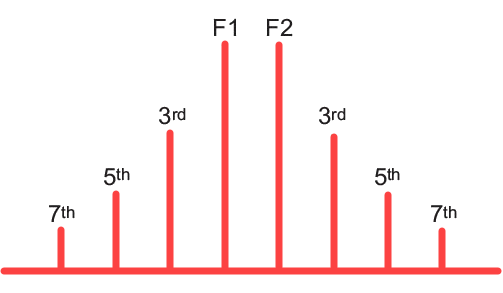PIM's Impact on LTE & Wi-Fi Signals
PIM, or Passive Intermodulation, is a type of self-interference signal distortion that has become increasingly important to detect and mitigate since LTE and Wi-Fi networks, which are now being deployed in great numbers, are particularly sensitive to it.
PIM occurs when a modulated carrier frequency is exposed to non-linear mixing from different sources in the RF chain. The resulting signal will contain additional, unwanted frequencies or intermodulation products that interfere with the downlink or uplink frequencies. As the “Passive” portion of the name implies, this non-linear mixing does not involve active devices and is frequently caused by the metallic materials and workmanship of the interconnects and other passive components in the system.

Examples of causes of non-linear mixing:
- Most metal surfaces have at least a thin layer of oxide which can cause tunneling, or simply cause a reduced area of conduction. Some believe that this produces the Shottky effect. This is why a rusty bolt or metal roof near a cell tower can produce a strong PIM distortion signal.
- Imperfect electrical connections: surfaces are never perfectly smooth, so the areas of contact can have high current densities which can cause heating through a restricted conduction path causing a resistance change. For this reason, connectors should always be tightened to the correct torque.
- Ferromagnetic material: materials such as iron can generate large PIM distortion and should not be used in the RF chain of cellular systems. Iron can be strategically used in antenna infrastructure, provided it is not exposed to high levels of RF energy.
As wireless networks become more complex with multiple technologies employing higher-modulation rates in use at a single site, the undesired intermodulated frequencies interferes with the downlink and uplink LTE/Wi-Fi signals. Antennas, cables, and dirty or loose connectors can be sources of PIM, as well as damaged RF equipment or metal objects near or at a distance from the cell site.
PIM interference can have substantial impacts on the performance of wireless networks, which is why it is so important to wireless operators and their contractors to be able to test for, locate, and mitigate PIM. Acceptable PIM levels vary by system, but as an example, test equipment manufacturer Anritsu, in drive tests, has found an 18% drop in download speeds when PIM levels were increased from -125 dBm to -105 dBm, even though the latter number can be considered an acceptable PIM level.
To protect your wireless network from the detrimental effects of PIM, KP Performance Antennas offers a range of Low PIM antennas that offer maximum coverage and high throughput.